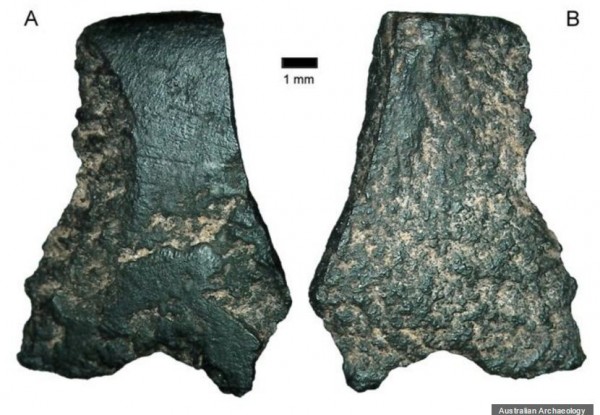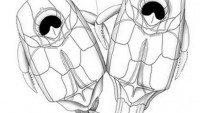Controversy Swirls around Claim World’s Oldest Hafted Axe was Made in Australia
| Arthur Dominic Villasanta | | May 11, 2016 03:45 AM EDT |
(Photo : ANU) A fragment of the oldest hafted axe in human history?
A minute stone flake from northwestern Australia dug up by an archaeologist over two decades ago is now being touted as the world's oldest example of a "hafted axe" or an axe with a handle. That claim is being questioned by other scientists.
The controversy involves a sliver of basalt just 11 millimeters long its discoverer, Prof. Sue O'Connor from the Australian National University, claims comes from the oldest hafted axe ever discovered. The fragment appears to have been ground smooth, evidence it had been worked on by human hands. She estimated the age of the axe at between 45,000 to 49,000 years old.
Like Us on Facebook
The fragment is 10,000 years older than the previous oldest known fragments found in 2010 in northern Australia. The discovery also coincides with the arrival of people in Australia. Archaeologists say hafted axes are normally associated with the development of agriculture.
The scientists that discovered the axe fragment claim it proves an adaptation to a new environment by the very first Australians.
"We know that they didn't have axes where they came from," said O'Connor. "There's no axes in the islands to our north. They arrived in Australia and innovated axes."
That claim is being disputed by Prof. John Shea, a stone tool expert at Stony Brook University in the United States. Prof. Shea noted that because the flake is the only one of its kind makes it difficult to draw confident conclusions as to its significance.
He noted that its smooth surface might have derived from other than human action. Even if it were an axe blade, there is no proof it was ever a hafted weapon.
"The evidence is essentially one flake -- one piece of stone out of hundreds and hundreds that they've excavated from this rock shelter site," according to the BBC. "They would make a stronger case if they could show that similar chips with edge abrasion occurred at a greater number of sites."
Similar objects of this kind could link this ancient discovery to times and locations where ground axes are more common. Without this link, there is "still reason for doubt" that the little fragment is, indeed, from an axe blade.
TagsAustralia, hafted axe, Prof. Sue O'Connor, Australian National University, Prof. John Shea, Stony Brook University, basalt
©2015 Chinatopix All rights reserved. Do not reproduce without permission
EDITOR'S PICKS
-

Did the Trump administration just announce plans for a trade war with ‘hostile’ China and Russia?
-

US Senate passes Taiwan travel bill slammed by China
-

As Yan Sihong’s family grieves, here are other Chinese students who went missing abroad. Some have never been found
-

Beijing blasts Western critics who ‘smear China’ with the term sharp power
-

China Envoy Seeks to Defuse Tensions With U.S. as a Trade War Brews
-

Singapore's Deputy PM Provides Bitcoin Vote of Confidence Amid China's Blanket Bans
-

China warns investors over risks in overseas virtual currency trading
-

Chinese government most trustworthy: survey
-

Kashima Antlers On Course For Back-To-Back Titles
MOST POPULAR
LATEST NEWS
Zhou Yongkang: China's Former Security Chief Sentenced to Life in Prison

China's former Chief of the Ministry of Public Security, Zhou Yongkang, has been given a life sentence after he was found guilty of abusing his office, bribery and deliberately ... Full Article
TRENDING STORY

China Pork Prices Expected to Stabilize As The Supplies Recover

Elephone P9000 Smartphone is now on Sale on Amazon India

There's a Big Chance Cliffhangers Won't Still Be Resolved When Grey's Anatomy Season 13 Returns

Supreme Court Ruled on Samsung vs Apple Dispute for Patent Infringement

Microsoft Surface Pro 5 Rumors and Release Date: What is the Latest?














